Induction Cooktop
For long slow cooking

Prepare in Quantitywith 16-quart Stockpot

China Cap Strainer in 3 sizes
Fine mesh for clear stocks. Also in coarse.
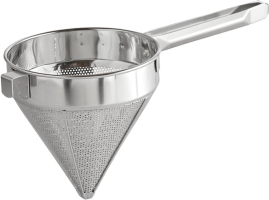
General Info
Basic Stock - Prudhomme
-----------BASIC------------
2 qt Cold water
1 ea Med. onion, (see note)
1 ea Large clove garlic (note)
1 x Bones, excess meat (notes)
----FOWL AND GAME STOCKS----
1 1/2 lb Backs, necks, bones (notes)
----BEEF OR TURTLE STOCK----
2 lb Beef shank (see notes)
---------PORK STOCK---------
2 lb Pork neck bones (see notes)
-------SEAFOOD STOCK--------
2 lb Rinsed shrimp heads (notes)
Notes: To the basic stock, you can also add vegetable trimmings from the recipe(s) you are serving, in place of the onion, garlic and celery. The recipe calls for the onion and garlic to be unpeeled and quartered. Also, you may include bones and any excess meat (excluding livers) from meat or poultry, or shells or carcasses from seafood, used in the recipe(s) you're cooking, or
FOR FOWL AND GAME STOCKS:
1 1/2 to 2 pounds backs, necks and/or bones from chickens, guinea hens, ducks, geese, rabbits, etc.
FOR BEEF OR TURTLE STOCKS:
1-1/2 to 2 pounds beef shank (preferred) or other beef or turtle bones.
FOR PORK STOCK:
1-1/2 to 2 pounds pork neck bones (preferred) or other pork bones.
FOR SEAFOOD STOCK:
1-1/2 to 2 pounds rinsed shrimp heads and/or shells, or crawfish heads and/or shells, or crab shells (2-1/2 to 3 quarts), or rinsed fish carcasses (heads and gills removed), or any combination of these. (you can also substitute oyster liquor for all or part of seafood stock called for in a recipe).
NOTE:
If desired, you can first roast meat bones and vegetables at 350F until thoroughly browned. Then use them to make your basic stock. (When you brown the bones and vegetables, the natural sugar in both caramelizes on the surface, which gives the stock a fuller taste and adds color when it dissolves in the stock water.) Always start with cold water--enough to cover the other stock ingredients. Place all ingredients in a stock pot or a large saucepan. Bring to a boil over high heat, then gently simmer at least 4 hours, preferably 8 (unless directed otherwise in a recipe), replenishing the water as needed to keep about 1 quart of liquid in the pan. The pot may be uncovered, or set the lid on it askew. Strain, cool and refrigerate until ready to use.
(Note: Remember if you are short on time, using a stock simmered 20 to 30 minutes is far better than using just water in any recipe..)
TO MAKE A RICH STOCK:
Strain the basic stock, then continue simmering until evaporation reduces the liquid by half or more. For example, if your recipe calls for 1 cup "Rich Stock," start it with at least 2 cups of strained basic stock. (Rich stocks are needed when a sauce requires lots of taste but only a limited amount of liquid, for example, "Oyster Sauce for Beef."
From:
The Prudhomme Family Cookbook
Posted by Fred Towner to rec.food.recipes
To Print or Pin the Recipe, or to Post and/or Read
Comments

Bone Stock
Toss the bones in a crockpot with 1 strip kombu seaweed, a bay leaf and a splash of red wine or cider vinegar, and a pinch of sea salt if desired. Pour rapidly boiling water into the pot, cover the lid with a folded towel, and leave it set on high all day long, adding more hot water if needed. This is Rachel Maetsz' recipe which she posted to the paleofood list about a year ago. The crockpot method was my idea, borrowed from Laurel's Kitchen (that's how I used to cook beans). When the broth is milky-white, strain out the bones and ladle the hot broth into warm, sterile wide-mouth jars. Don't put the lids on too tight or you'll never be able to get them off. Put the jars to cool on a cake rack. When they are cool enough for the fridge, move them there. The jars should seal. If any jar doesn't seal properly, use it first (obviously).
We use all bones except vertebrae and fish bones. The poultry and rabbit bones are cooked in one pot, all other bones in a separate batch. Even if we or our guests (<--well, theoretically, LOL!) have eaten off the bones, we use them for broth.
By Stacie Tolen. Posted to the PaleoRecipe Mailing List, Aug. 2001
To Print the Recipe, or to Post and/or Read
Comments

Brown Stock
I use bones to make brown stock. Any french or classical cookbook should have a detailed recipe for this, but the basic procedure is as follows. Brown the bones on a sheet pan in the oven (400 degrees for about an hour). Reserve oil, remove the bones to a pot of water, deglaze sheet pan and add drippings to broth. Toss mirepoix (coarsely chopped onion, carrot and celery) in the reserved oil, brown the mirepoix in the oven, and add it to the broth. Add spices as desired ("bouquet garni"), and simmer without boiling for several hours. Do not add salt. Strain and cool.
Brown stock keeps quite well frozen. I separate it into pint containers and store it for several months.
Brown stock can be used for nearly everything. I use it as the base for chili, curry, stew, gravy, and soup.
By Bruce Sherrod. Posted to the PaleoRecipe Mailing List, Aug. 2001
To Print the Recipe, or to Post and/or Read
Comments

Bones and Broth
My brother's fiancee dumps them in a crockpot with bottled barbecue sauce (of different flavors) and just lets them stew. It is delicious. Very tender and easy!
As for bones... place on pan and broil for appr. 10 minutes or until brown. Cool and add to cold water. Slowly bring to boil and skim off sludge.. (smile). Lower to simmer and leave on 24-48 hours. By adding at least 1 Tablespoon of vinegar or lemon juice in the beginning you will bring out the calcium in the bones. So the broth will be a good source of calcium. I mix is with tomato juice, tobasco sauce, sea salt, lemon and Worchester for a pre-dinner drink (no alcohol). The stomach reacts to fat by producing bile which is needed to properly digest protein so it is excellent as "nutrition" to drink before dinner. You may or may not want to reduce the broth. As I do not want to drink much I like to reduce it and only need to add appr. 2 Tablespoons to make a drink. *IMPORTANT* This recipe is for grass-fed animals. I am right now boiling store-bought beef bones of grain fed animals. The broth is different. I'm not sure how much broth I am getting. It seems to be all fat. I do know I added 2 carrots and several stalks of celery and the taste is much better than the first batch. I also added just a little sea salt this time as I do not plan on using the broth as a soup base. Be careful with the salt. I recommend adding it only at the end. Let the bones and soup cool some, and then STRAIN. I recommend using a strainer AND also cheesecloth on the last strain or you will have some grit. There are little to no nutrients in this. The value is in the calcium and gelatin. Once you put the liquid into different containers and in the refrigerator it will separate. I scooped out and discarded the fat from my first batch (the grass-fed beef) but am now attempting Pemmican since I saw the recipe here!! Whether the fat from grain fed beef will be acceptable I do not know. Certainly the taste is quite different. I doubt I will use it. I already dried grass-fed buffalo meat. My understanding is that the fat, or suet, is better used from around the kidney. To harvest that you would probably need to buy the beef on the hoof. I got it with my beef last year but did not know what to do with it unfortunately and ended up not using it. I understand that the minerals and vitamins of the animals are stored in the fat around the kidneys. And it is a LOT of fat ! From one cow I got fat the size of a very large watermelon! This is the best source of fat for Pemmican. The reason it may be "tasteless" to the modern palate is because of the poor food source. The fat of grass-fed animals is delicious.
After the value of the calcium, and the fat if you use it, is the the gelatin. The broth will cool and form into a gelatin. This gelatin facilitates the assimilation and transportation of vitamins and nutrients in our bodies. Absorption is a vital part of vitamin reception. We can eat huge amounts and not get nutrients.
The same is true for chickens. I simmered the bones, and bought extra bags of feet, for at least 48 hours. The bones are quite soft afterwards. I've read that the natives dried the bones and ate them as we might "chips" when food was more scarce. The feet also provides important and additional gelatin.
Although you did not ask about fish broth I will tell you my experience. Just for fun I made it. Be careful to use non-fatty fish. Put in all the whole fish. Vitamin A is in the eyes and is the only source for some natives. I never wondered why people had "fish head soup", just accepting it as a native dish, but all the native dishes of (healthy) cultures are important for a reason. Please note that fish broth is not for drinking. As a matter of fact it tastes terrible. I finally used it in a recipe for homemade clam chowder out of the cookbook Nourishing Traditions. On faith. And wow. It was incredible.
My cooking experience is very limited but these are the results of my experiments.
By Anne. Posted to the PaleoRecipe Mailing List, Sept. 2001
To Print the Recipe, or to Post and/or Read
Comments

Fish
Master Recipe for Fish Stock
3 lb Fish trimmings; rinsed -cut in 3" pieces
1 md Onion; diced small
2 md Carrots; diced small
1 lg Celery stalk; diced small
8 Parsley stems; chopped
1 c Dry white wine
1/4 Lemon
10 Black peppercorns
2 Bay leaves
1 Dried chili pepper
Note: Fish heads, tails, and bones are all possibilities for trimming and can be used for the stock. An equal amount of shrimp and lobster or crab carcasses can be substituted for the fish bones.
Put all ingredients in a 6-to-8-quart pot. Cover with 2 3/4 quarts cold water. Bring to a boil over medium heat; simmer slowly for about 1 hour, periodically skimming away scum that rises to the surface. Strain stock through double thickness of cheesecloth, pressing out as much liquid as possible with the back of a spoon. Use to make fish soups, stews, etc. The stock can be cooled and refrigerated for up to 3 days or frozen for up to 3 months. Yield: 2 1/2 quarts
Cook's Illustrated Nov/Dec 94
From the recipe collection of Fred Towner
To Print or Pin the Recipe, or to Post and/or Read
Comments
 Fedor Selivanov / 123RF Stock Photo 13926355
Fedor Selivanov / 123RF Stock Photo 13926355
Shrimp Stock
This simple stock adds great flavor to many seafood dishes. Use it for outstanding depth of flavor in soups and chowders.
2 pounds shrimp heads, shells, or both
1 medium onion, quartered
1 garlic clove
1 celery rib
1 carrot, chopped
1/2 cup white wine
Preheat the oven to 350 degrees. Spread the shrimp heads and shells in a baking pan, and roast them until the shells are red and all the liquid has evaporated.
Sweat the onion, garlic, celery and carrot in a large pot. Add the shrimp heads and shells, and cover with cold water (it's important that the water be cold). Bring the water and shrimp heads and shells to a boil. Pour the white wine into the pan in which the shrimp heads and shells were roasted, and scrape the bottom of the pan. Add the wine and scrapings to the stock.
Simmer the stock for at least 1 hour, uncovered, adding liquid if the level in the pot falls below 1 quart. Strain the stock, and reserve it. Yields 1 quart.
From:
Traveling Jamaica With Knife, Fork & Spoon by Robb Walsh and Jay McCarthy
To Print or Pin the Recipe, or to Post and/or Read
Comments

Beef
Beef Marrow Bones
Based on Joan Nathan's cooking show (
Jewish Cooking in America [archive.org])
6 lbs. beef short ribs
2 lbs. carrots, sliced
1 onion, chopped
4 beef marrow bones (more than original recipe)
10 juniper berries (not in original recipe)
dried thyme and parsley
1/4 c. water
Into the oven at 200 for about 6 hours so far...looking good. You can cut the meat with a wooden spoon.
But next time I would like a little more substance. Does anyone think celeriac might work here? Will it absorb some water and add a starchy quality? I haven't tried celeriac yet; each time I think of it, they don't have any at the market. Anyway, here is the basic recipe.
By Stacie Tolen. Posted to the PaleoRecipe Mailing List, Nov. 2000
To Print or Pin the Recipe, or to Post and/or Read
Comments
Beef Essence Or Extract
"To cook a heap of bones, beef and vegetables in a big pot for many hours and have to show for it a small jar or two of meat essence is truly making a molehill out of a mountain--but such a molehill! Possessing a batch of this essence--glace de viande, is like having 8 quarts of strong beef stock miraculously confined in a small container. Use it any time you like and keep it as long as you care to--it is virtually immortal if frozen and keeps several weeks refrigerated.
Add a Tbsp. of the essence to a cup of boiling water and you have better and beefier broth than any you can buy canned, cubed, or powdered. A little of this concentrate, stirred into any meat flavored preparation, adds both body and savor. Glace de viande can rescue a pallid soup, a vapid sauce, or a lackluster gravy, or it can be a sauce base on its own. The extract is unsalted, for greater versatility when added to sauces and such so add 1/4 tsp. of salt to the cup if your drinking the broth.
Makes 2 cups (reconstituted, about 8 quarts, or 1 cup of broth per Tbsp. of essence.
6 pounds (or more) beef and veal bones, sawed into pieces by the butcher (try to have the pieces cut no more than 2 to 3 inches long or wide.) 3-1/2 to 4 pounds boneless shin of beef, cut into 1 inch cubes 2 large, unpeeled onions, one sliced, the other left whole 2 large carrots, scrubbed and cut up coarsely Water as needed 2 ribs of celery, with leaves, cut up 1/2 tsp. dried thyme, crumbled 1 medium bay leaf 1 whole clove 2 ripe tomatoes, coarsely chunked 1 unpeeled clove garlic, left whole 2 or 3 sprigs parsley
Preheat the oven to 450 degrees. In one or two large, shallow roasting pans spread all the bones and half of the shin beef, reserving the other half in the refrigerator. Add the sliced onion and the cut up carrots. Put the pan or pans into the oven and brown the ingredients for 40 to 50 minutes, stirring and turning them from time to time; you want a good brown color.
Pour off any fat and put the bones, meat, and vegetables into a very large stock pot. Pour 2 or 3 cups of water into the roasting pan(s), then set over direct heat and stir and scrape to dissolve all the brown bits. Pour the deglazing liquid into the stock pot. Add enough water to cover everything by about 2 inches. Add the celery, thyme, bay leaf, the second onion (stuck with a single clove, tomatoes, garlic, and parsley.
Bring the liquid to a boil, then adjust the heat so that the pot, partially covered, maintain a gentle simmer, with only an occasional bubble. Skim off any foam at the beginning and cook everything for 7 or 8 hours, skimming occasionally (this is to achieve clarity in the finished essence). The simmering can be interrupted for several hours, or overnight; let the pot sit, uncovered, for up to 8 hours at room temperature, then resume cooking when convenient. (Refrigerate for longer times or if the weather is warm.)
After you judge all possible flavor has been extracted from the solids in the pot, strain them all out, pressing on them with a spoon to extract all the juices. Skim all fat from the strained broth, which by now will amount to about 4 or 5 quarts. Strain the broth through a cheesecloth-lined strainer into the washed out pot (or into a smaller one) and add the remaining beef, which you have meanwhile chopped or ground to the fineness of hamburger.
Resume simmering, skimming off fat and scum about every half hour. After cooking the stock with the beef for 1-1/2 hours, strain out the meat, pressing it to extract all possible flavor. Strain the broth through the cheesecloth again a begin the final reduction. Resume simmering the stock, cooking the ever-strengthening essence gently as long as necessary for it to become a syrupy substance that will coat a cool metal spoon; this may take up to 2 hours. (For the clearest essence, skim frequently. However, the flavor of the finished product will be fine if you aren't too fussy about the skimming; just be sure to skim off any fat that appears.
The essence is finished when it passes the metal-spoon test. Strain it through a fine meshed metal strainer into small jars or pots and let it cool, uncovered. Cover it closely and store in the refrigerator, or freeze it. If frozen, scoop out with a hot spoon as needed.
Note: The exact yield will depend on how much collagen was contained in the bones and meat--the more collagen, the sooner the jellying stage is reached. The cooled essence will be firm, almost rubbery, and highly concentrated in flavor. If any surface mold should eventually develop, remove it--it's harmless.
From:
Better Than Store Bought
Shared By: Pat Stockett
From the recipe collection of Fred Towner
To Print or Pin the Recipe, or to Post and/or Read
Comments
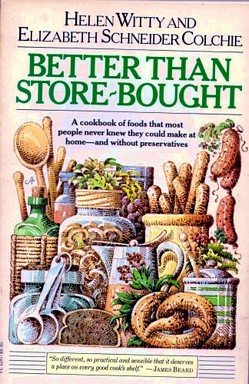
Beef Stock - Master Chefs
2 tb Oil, vegetable
6 lb Bones, beef, meaty
2 md Onions, trimmed, quartered don't peel
2 lg Carrots, peeled, trimmed coarsely chopped
2 Celery, stalks, trimmed, coarsely chopped
1 Leek, trimmed, halved lengthwise, coarsely chopped, (white and green parts)
4 Garlic, cloves, unpeeled
1 bn Parsley, stems
2 c Water, plus more as needed
2 md Tomatoes, fresh or canned, cored, coarsely chopped
1/2 ts Thyme, dried, or
3 Thyme, sprigs
2 Bay leaf
2 Cloves
3/4 ts Salt, coarse
8 Peppercorns
Preheat oven to 450 degrees F. Put the oil in a roasting pan and heat briefly in the oven. Add the bones to the oil in the pan, toss to coat and roast for 35 minutes. Add the onions, carrots, celery, leek, garlic, and parsley, tossing them all to coat with fat. Roast 30 minutes longer. Remove the pan from the oven and transfer the bones and vegetables to a clean stockpot. Drain off as much of the fat as possible. Place the roasting pan over medium-high heat (use 2 burners if necessary), and add 2 cups of cold water and boil briefly. Scrape up all of the browned bits into the water. Transfer the liquid to the stock pot and add enough cold water to cover. Bring slowly to a boil, skimming off all of the froth that forms. Lower the heat and add tomatoes, thyme, bay leaves, cloves, and salt. Simmer uncovered for 6 to 8 hours adding water as necessary just to cover the ingredients. Skim whenever necessary. Add peppercorns for the last 15 minutes of the simmering.
Strain the "soup" into a large bowl through a colander lined with a double layer of dampened cheesecloth. Gently press the solids to extract all of the liquid, and discard the solids. Pour the stock into containers for storage and label and date them. The stock will "keep" for up to 3 days in a refrigerator, and up to 6 months in a freezer. Yield: 2 quarts
Source: New York's Master Chefs, Bon Appétit Magazine, Written by Richard Sax, Photographs by Nancy McFarland The Knapp Press, Los Angeles, 1985
From the recipe collection of Fred Towner
To Print or Pin the Recipe, or to Post and/or Read
Comments
Basic Beef Stock No. 213
4 lbs beef, meaty, raw, or
4 lbs veal bones
2 large onions, chopped
3 carrots, coarsely chopped
3 ribs celery with leaves, chopped
2 cloves garlic
5 parsley sprigs
1 bay leaf
4 whole cloves
10 peppercorns
salt to taste
3 1/2 quarts cold water, divided
Roast the bones in a large pan in a hot oven (about 450 degrees) for 30 minutes, turning them once. Meanwhile, in a large, heavy stock pot, combine the onions, carrots, celery, garlic, parsley, bay leaf, cloves, peppercorns, salt and first measure of water. Bring to a boil. Reduce the heat. Add the roasted bones. Pour off the fat from the roasting pan. Add the second measure of water to the pan, scraping the bottom and sides with a wooden spoon. Pour this liquid into the stock pot. Return it to a boil. Reduce the heat. Let simmer, partially covered, for 3 hours. Skim off froth as needed. Continue simmering, partially covered, for another 2 hours. Pour the broth through a fine strainer or sieve. Use immediately or refrigerate. Yields 8 Cups
Posted by Joel Ehrlich to rec.food.recipes on Feb 15, 1998.
Adapted by DW.
To Print or Pin the Recipe, or to Post and/or Read
Comments
Beef Stock No. 418
4 lbs shin bones
3 qts water
1 cup onions, sliced
1 cup carrots, sliced
1 cup celery, sliced
1 bay leaf
1/2 tsp thyme, dried
4 whole peppercorns, black
2 sprigs parsley, fresh
Put the bones in a large kettle. Cover with cold water. Bring to a boil for 2 minutes. Drain. Return the bones to the kettle. Add the measured amount of water, the onions, carrots, celery, bay leaf, thyme, peppercorns, and parsley. Bring to a boil and simmer for 4 hours, skimming the fat and foam from the surface. Strain the stock. Discard the solids. Leftover stock can be frozen. Yields 10 Servings
Posted by Joel Ehrlich to rec.food.recipes on July 3, 1995.
To Print or Pin the Recipe, or to Post and/or Read
Comments
Beef Stock (Caldo de Res)
3 lb Shin and marrow bones of beef
2 qt Water
1 Carrot, chopped
3 Stalks celery, chopped
2 Tomatoes, chopped
1 md Onion, chopped
1 Bouquet garni (made with 1 thyme sprig, 5 black peppercorns, and 1 parsley sprig, tied up together in a 4" square of cheesecloth)
Preheat the oven to 350F. Place the bones in a roasting pan and bake approximately 30 minutes, until the bones are well browned, turning over once.
Place the browned bones and the remaining ingredients in a large pot. Cover and bring to a boil, then reduce the heat to medium, uncover, and simmer for 3 hours.
Strain the stock through a fine sieve lined with 2 layers of damp cheesecloth. Use the stock in another recipe or cover and save in refrigerator or freeze until ready to use.
~NOTE~ Beef stock is nice to have on hand. You may freeze any leftover stock in ice cube trays. Pop out and store in plastic bags so that you have any amount of stock available when you need it. It will last 2 to 3 days, unfrozen, in the refrigerator or up to 6 months in the freezer.
Source:
A Taste of Cuba
Posted by Bobbie Mikes to rec.food.recipes on July 4, 1995.
To Print or Pin the Recipe, or to Post and/or Read
Comments
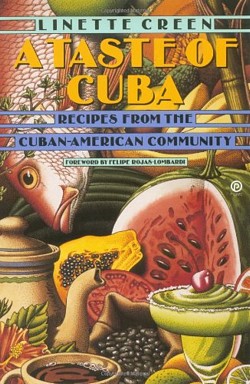
Veal or Beef Stock Au Jus
Makes about 9 pints stock or 1.5 pints jus.
Please note pints are UK pints (i.e. 20 fl oz)
3 onions halved
2-3 tablespoons water
5lb veal or beef bones
8oz veal or beef trimmings
8oz carrots, coarsely chopped
3 celery sticks, coarsely chopped
1 leek, chopped
3-4 tomatoes, chopped
1 garlic clove, halved
1 bay leaf
1 sprig of fresh thyme
Pre-heat the oven to 110 degrees C/225F.
Lay the onion halves flat in a roasting tray with the water. Place in the very cool oven and allow to caramelise slowly until they have totally softened and coloured. This process will take 1-2 hours. The sugars in the onions will slowly cook and give a wonderful taste. Put the onions into a very large pot.
Increase the oven temperature to 200 degrees C/400F. Place all the bones and trimmings in a roasting tray and roast for about 30 minutes until well coloured. Roast the chopped carrots and celery in another roasting tray for about 20 minutes until lightly coloured.
When ready, add the bones, trimmings and vegetables to the onions in the pot along with the leeks, tomatoes, garlic, bay leaf and thyme. Fill the pot with cold water - you'll need about 9 pints. Bring the stock to the simmer and skim off any impurities. Allow to cook for 6-8 hours - with this you will achieve the maximum taste.
When ready, drain and discard the bones and vegetables. This is now your veal/beef stock and you can cool it and freeze it in convenient quantities.
Alternatively, you can make a jus from the stock. Allow the liquid to boil and reduce down to about 1.5 pints, skimming occasionally. The stock should now be thick and of a sauce consistency. Make sure that you taste all the time during reduction. If the sauce tastes right but is not thick enough, thicken it lightly with cornflour (cornstarch?) mixed with water. You now have a classic jus to which you can add the juices from your roast, if you wish (after skimming off the fat).
From: Gary Rhodes
Posted by Sarah Holford to rec.food.recipes on Jan 2, 1998.
To Print or Pin the Recipe, or to Post and/or Read
Comments
Veal
Veal Stock - Master Chefs
2 tb Oil, vegetable
6 lb Bones, veal, meaty, OR combination of veal and beef bones
2 md Onions, trimmed, quartered don't peel
2 lg Carrots, peeled, trimmed coarsely chopped
2 ea Celery, stalks, trimmed, coarsely chopped
1 ea Leek, trimmed, halved lengthwise, coarsely chopped, (white and green parts)
4 ea Garlic, cloves, unpeeled
1 bn Parsley, stems
2 c Water, plus more as needed
2 md Tomatoes, fresh or canned, cored, coarsely chopped
1/2 ts Thyme, dried, or
3 ea Thyme, sprigs
2 ea Bay leaf
2 ea Cloves
3/4 ts Salt, coarse
8 ea Peppercorns
Preheat oven to 450 degrees F. Put the oil in a roasting pan and heat briefly in the oven. Add the bones to the oil in the pan, toss to coat and roast for 35 minutes. Add the onions, carrots, celery, leek, garlic and parsley, tossing them all to coat with fat. Roast 30 minutes longer. Remove the pan from the oven and transfer the bones and vegetables to a clean stockpot. Drain off as much of the fat as possible. Place the roasting pan over medium-high heat (use 2 burners if necessary, and add 2 cups of cold water and boil briefly. Scrape up all of the browned bits into the water.
Transfer the liquid to the stock pot and add enough cold water to cover. Bring slowly to a boil, skimming off all of the froth that forms. Lower the heat and add tomatoes, thyme, bay leaves, cloves and salt. Simmer uncovered for 6 to 8 hours adding water as necessary just to cover the ingredients. Skim whenever necessary. Add peppercorns for the last 15 minutes of the simmering. Strain the "soup" into a large bowl through a colander lined with a double layer of dampened cheesecloth. Gently press the solids to extract all of the liquid, and discard the solids. Pour the stock into containers for storage and label and date them. The stock will "keep" for up to 3 days in a refrigerator, and up to 6 months in a freezer. Yield: 2 quarts
Source: New York's Master Chefs, Bon Appétit Magazine, Written by Richard Sax, Photographs by Nancy McFarland; The Knapp Press, Los Angeles, 1985
From the recipe collection of Fred Towner
To Print the Recipe, or to Post and/or Read
Comments

Veal Stock
5 lb Veal bones (loin or knuckle)
1 tb Olive oil
5 Ripe tomatoes, quartered
2 Leeks, coarsely chopped
5 Celery stalks, coarsely chopped
4 lg Carrots, coarsely chopped
6 qt Water
4 Bay leaves
1 Bunch fresh parsley
2 Bunches fresh thyme
Preheat the oven to 450 degrees F. Put bones in a large roasting pan and brown in the oven about 1 hour, turning them every 20 minutes. Remove from the oven and set aside.
In a large stock pot combine the olive oil, tomatoes, leeks, celery, and carrots and saute over high heat for 15 minutes, stirring constantly.
Add the bones, water, and herbs and bring to a boil over medium heat.
Reduce heat and simmer for 4 1/2 to 5 hours, skimming the surface every half hour until all remnants of fat and foam disappear. Remove from heat and carefully strain the stock through a sieve lined with cheesecloth. Discard the contents of the sieve.
Refrigerate stock 3 hours, then remove solidified fat from the top.
The stock will keep 5 days in a covered container.
Although better fresh, the stock can also be frozen in ice cube trays; the cubes can be stored in plastic bags in the freezer for several months. Larger quantities of stock can be poured directly into plastic bags and stored in the freezer.
NOTE: The flavor of veal stock is unlike that of any other stock; it has a distinctively delicious taste. I strongly advise you to use veal stock when it is suggested in a recipe. The loin bones and knuckles can be purchased at your local butcher; usually they are available in the early morning. Be sure to ask for bones with the marrow, which contains most of the flavor. Yield: 4 quarts
From
Native American Cooking by Lois Ellen Frank
From the recipe collection of Fred Towner
To Print or Pin the Recipe, or to Post and/or Read
Comments
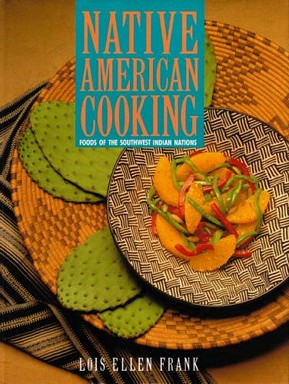
Chicken
Chicken Stock - Master Chefs
5 lb Chicken, parts, (backs, necks, carcasses, and giblets), (no livers)
2 lg Onions, coarsely chopped
2 md Carrots, peeled, trimmed coarsely chopped
2 lg Celery, stalks, with leaves, trimmed, coarsely chopped
2 Garlic, cloves, crushed
1 bn Parsley, stems
2 Thyme, sprigs, OR 1 pn Thyme, dried
1 Bay leaf
1/2 ts Salt, coarse
6 Peppercorns
Wash chicken parts well and place them in a large stockpot. Add cold water to cover by about 2 inches and slowly bring to a boil, skimming all of the froth from the surface as it forms. Lower the heat and add all of the remaining ingredients except the peppercorns. Simmer, uncovered, for 3 hours. Add water as needed to cover the ingredients and skim when necessary. Add peppercorns for the last fifteen minutes of the simmering process. Strain the "soup" into a large bowl through a colander lined with a double layer of dampened cheesecloth. Gently press the solids to extract all of the liquid possible. Discard the solids and cool the liquid to room temperature. Refrigerate until chilled and lift off the solid fat that forms at the surface. Discard the fats. Pour the stock into containers for storage, label and date. Stock keeps for about 3 days in the refrigerator, and up to six months in the freezer. Yield: 3 to 4 quarts
Source: New York's Master Chefs, Bon Appétit Magazine, Written by Richard Sax, Photographs by Nancy McFarland; The Knapp Press, Los Angeles, 1985
From the recipe collection of Fred Towner
To Print or Pin the Recipe, or to Post and/or Read
Comments
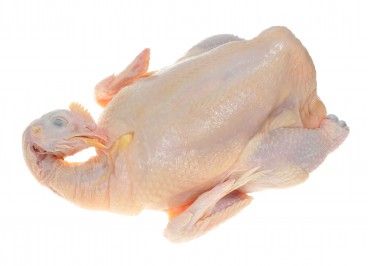 Choo Poh Guan / 123RF Stock Photo 9577387
Choo Poh Guan / 123RF Stock Photo 9577387
Basic Chicken Stock No. 214
2 lbs chicken scraps, including some bones
2 quarts cold water, to cover
1 large onion, peeled and stuck with
4 cloves
1 large garlic clove, peeled
2 ribs celery, halved crosswise, with leaves if available
2 carrots, cut into chunks
1 bay leaf
2 sprigs parsley, or
1 tbls parsley flakes, dried
1 tsp tarragon
1/2 tsp thyme
1/2 tsp dillweed
salt, if desired, to taste
12 peppercorns, or
1/2 tsp black pepper, freshly ground
Place all the ingredients in a large pot with a cover. Bring to a boil. Reduce the heat. Partially cover the pot. Simmer for at least 1 hour. The longer the stock cooks, the richer it will become. But don't cook it until the broth evaporates.Pour the stock through a fine strainer, sieve or cheesecloth into a fat separating measuring cup, bowl or other suitable container. Press on the solids to extract as much liquid as possible. If using the fat skimmer, decant the fat-free broth into containers for storage. Otherwise, refrigerate the broth until the fat hardens enough for easy removal. (Depending on the amount of gelatinous protein in the chicken scraps, the broth may gel at refrigerator temperatures.) Yields 5 Cups
Posted by Joel Ehrlich to rec.food.recipes on Feb 15, 1998.
To Print or Pin the Recipe, or to Post and/or Read
Comments
 Choo Poh Guan / 123RF Stock Photo 9577387
Choo Poh Guan / 123RF Stock Photo 9577387
Chicken Stock No. 417
4 lbs chicken bones
8 cups water
4 whole peppercorns, black
1 cup onions, quartered
1/2 cup carrots, chopped
1/2 cup celery, chopped
4 sprigs parsley
1 bay leaf
1/2 tsp thyme, dried
1 clove, whole
1 garlic clove
Put the bones and all ingredients in a kettle. Bring to a boil. Reduce heat to a simmer. Simmer, uncovered, for 1 hour. Skim from time to time to remove the fat and foam from the top. Strain the stock through a piece of cheesecloth or through a fine-screened strainer. Discard the solids. Leftover stock can be frozen. Yields 6 Servings
Posted by Joel Ehrlich to rec.food.recipes on July 3, 1995.
To Print or Pin the Recipe, or to Post and/or Read
Comments
 Choo Poh Guan / 123RF Stock Photo 9577387
Choo Poh Guan / 123RF Stock Photo 9577387
Lei's Chinese Chicken Stock
2 pounds chicken neck, backs or other parts
water to cover, about 7-8 cups
1 tablespoon sherry
2 tablespoons salt
1 carrot, pared and sliced
1/4 teaspoon ground ginger
1/8 teaspoon pepper
1 scallion chopped or small onion, chopped
Bring water to a boil. Add chicken and rest of ingredients. Boiled in a covered pan for 1 1/2 hours. Lower heat and simmer for another 1/2 hour. Strain. Save chicken for Chicken salad.
Posted by LeiG@aol.com to rec.food.recipes on Dec 7, 1996.
To Print or Pin the Recipe, or to Post and/or Read
Comments
 Choo Poh Guan / 123RF Stock Photo 9577387
Choo Poh Guan / 123RF Stock Photo 9577387
Chicken Stock (Caldo de Pollo)
2 Whole chicken carcasses
2 qt Water
2 lg Onions
4 Whole garlic cloves
3 Carrots
2 Celery stalks
1 Bouquet garni (made with 1 thyme sprig, 5 peppercorns and a
parsley sprig tied up together in a 4" square of cheesecloth)
Salt and freshly ground black pepper to taste
Place the chicken in a large soup or stock pot and cover with the water (the pot will be about 2/3'rds full) Add the onions, garlic, carrots, celery and bouquet garni, and salt and pepper to taste. Bring to a boil over high heat. Skim off any scum that comes to the surface.
Reduce the heat and simmer approximately 4 hours, skimming regularly. Strain the stock through a strainer. Degrease with a ladle or by chilling stock, letting fat coagulate on the surface, and spooning off. Use the broth in another recipe or refrigerate or freeze for later use.
~NOTE~ Chicken stock can be made with two whole chicken breasts, skinless and with bones. Make sure all excess fat has been trimmed off and discarded. Stock can be saved for up to a week in the refrigerator or frozen for later use. It's handy to freeze some of the stock in ice cube trays so that when a recipe calls for a small amount it is easily accessible. Stock will keep up to 6 months frozen.
Source:
A Taste of Cuba
Posted by Bobbie Mikes to rec.food.recipes on July 4, 1995.
To Print or Pin the Recipe, or to Post and/or Read
Comments






